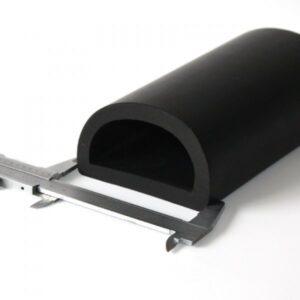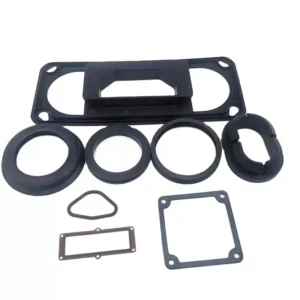Both seal strips and gaskets are essential parts of every mechanical construction. Starting from small machinery to large buildings need rubber strips and gaskets. But sometimes, we misunderstand between rubber strips and gaskets due to lack of experience.
So, this article aims to differentiate between seal strips and rubber gaskets. We will introduce different shapes, sizes, and manufacturing materials to various applications starting from the definition. At the end of this article, we have also prepared a quick summary table so that you can get a short idea of seal strips vs. rubber gaskets.
What are seal strips?
Seal strips are protective parts made of synthetic rubber typically used to protect against leakage of liquid and gas. Seal strips have different shapes and sizes depending on the channels and edges of the target equipment. Examples are weather stripping, boat seal strips, container seal strips, door bottom seals, etc.

Purpose: The primary purpose of seal strips is to eliminate the liquid or gas stream that flows around the equipment. Depending on the use state, they act as a barrier against different media. For example, door and window seal strips act as weather barriers. On the other hand, boat seal strips act as a water barrier, and container seal strips act as an air or water barrier.
Many options exist for seal strips to benefit humans. Below are a few of the most popular advantages of seal strips.
- Harsh weather protection: Rubber seals can withstand excessive heat and high UV and ozone levels. Therefore, door and window seal strips are famous examples of weather protection seals. Besides, seal strips protect sensitive machine parts and crew in a vehicle.
- Air and water protection: Most boats and ships need seal strips to make an airtight structure. Rubber strips not only make the boat structure airtight but also make it flexible. Besides, the large containers also require a seal strip to make the edges airtight. Therefore, heavy rain or sea storms can hardly affect the inside items in a container.
- Helps in long-lasting: Using a seal strip makes a mechanism flexible. Therefore, it becomes stable and durable.
What are gaskets?
Everything near us has gaskets. Even the car we drive and the place we work use gaskets. Besides, the keyboard I am typing on has gaskets under every key. Gaskets, called O-rings or washers, are mechanical seals that fill the gap between two surfaces. Rubber gaskets are very popular in various industries, including food and beverage, oil, and gas.

Gaskets usually prevent leakage between two joints under compression. O rings, pipe gaskets, and oil seals are the most common rubber gaskets in most machinery.
Purpose:The primary purpose of gaskets is to prevent leakage between two joints under compressions. Besides, It also fills the irregular cavities within two surfaces. Gaskets make a joint flexible, which reduces friction. As a result, the equipment becomes stable and durable for a long time.
There are a handful of benefits to rubber gaskets. Among them, we take a few demonstrating the importance of rubber gaskets gaskets.
- Liquid and Gas Resistance: Rubber gaskets that require chemical resistance are popular in chemical facilities. It is expected to be a sealant in draining pipes. Besides, the pneumatic system also requires rubber gaskets for leakage protection.
- Temperature Protection: Industries like water, gas, and petrochemicals utilize temperature-resistant rubber gaskets. The high-temperature rubber gasket can withstand up to 1000 degrees Celsius.
- Gaskets make machinery Safe: Rubber gaskets ensure any mechanical system’s safety as gaskets make the mechanism flexible and stable.
- Can Absorb High Pressure: Rubber gaskets are incredibly durable. Therefore, it can absorb high pressure, increasing a machine’s overall strength.
Shapes and Sizes
Both Rubber strips and gaskets have different shapes and sizes depending on the purpose of the applications. Let’s introduce the most common rubber shapes and sizes.
- Seal strips: Seal strips come in many shapes and sizes. The most common rubber shapes are typical d shape rubber seals, double d shape rubber seals, closed D shape rubber seals, t-shape rubber seals, U-shape extrusion NBR nitrile rubber seals, b-shaped, v, h, I, c, J, and x-shaped rubber seal strips. Besides, seal strips have other unique designs for cabinets, windows, and doors as weather stripping. In addition, there are complex shapes specially designed for some applications. Such as seal strips for glass shower doors, car window seals, window rubber strips for marine ships, rubber water stop for concrete joints, EPDM seals for the automotive windshield, heat-resistant extruded rubber sealing strips for automotive parts, windscreen rubber seals, etc.
- Rubber gaskets: The common rubber gasket shapes are O-rings or circle gaskets, Mickey Mouse gaskets, blanking gaskets, tabbed gaskets, fiber washers, paper gaskets, cylinder head gaskets, rectangular picture frame gaskets, full-faced flange gasket, manifold style gasket. However, gasket design depends on industrial usage, budget, and chemical and physical parameters. Based on these parameters, rubber gaskets have common shapes: sheet gaskets, solid gaskets, spiral wounds, constant seating, double-jacket, cam profile gasket, fishbone, and flange gasket. Other than these, some complex rubber gasket designs are for special applications.
Manufacturing Materials
There are various options when choosing a seal strip or rubber gasket material. Rubber and PVC are generally famous as seal strips and gasket materials. Technically, the type of materials depends on the projected applications. Choosing the right one can promise two times longer lifespan and withstand higher pressure.
The materials for rubber gaskets and seals are similar as they are both made for protection from liquid and gas bypass. On the other hand, rubber and seals can withstand high temperatures depending on the material type.
Usually, the rubber materials used for rubber gaskets and seals are neoprene, natural rubber, nitrile, EPDM, Silicone rubber, SBR, Viton, butyl, polyurethane, etc. Neoprene, nitrile, EPDM, and silicone are the most popular rubber seal-striped materials. Besides, other materials such as PVC, TPE, and TMV are also famous for seal strips.
Nitrile, EPDM, Neoprene, Silicone Rubber, and Viton are ideal for temperatures ranging from -55 to 300 degrees Celcius. These materials are perfect for use with water and oil. They are perfectly resistant to acids and abrasions. Finally, these rubber materials have an ideal impermeability to gases.
Applications
Seal strips and Rubber gaskets are made for different applications. Seal strips prevent the bypass between two various media, and gaskets prevent leakage and can withstand higher pressure.
Seal Strip
Rubber strips are an essential part of most buildings and vehicles. The following are the most popular applications of seal strips.
- Protect harsh weather: Strips for weather, also known as weather stripping, are integral to every building and apartment. These rubber strips protect against severe weather and keep the indoor temperature constant.
- Automotive: Trains and automotive vehicles use seal strips on the window to make them airtight. Therefore, dust and water drops can’t get inside. In addition, the rubber strips keep the inside temperature constant in the vehicle.
- Marine/boat/ container: Larger boats, ships, and containers use seal strips to make them airtight. Therefore, a giant sea disaster can hardly affect the inside equipment.
Rubber Gasket
On the other hand, rubber gaskets are integral to all mechanical systems. Rubber gaskets are typically great for plumbing and piping applications. Besides, rubber gaskets can also used in the following industrial applications.
- Chemical Processing Machinery: Inorganic acids, alkaline liquids, polar and non-polar solvents, organic bases, oils, amines, etc.
- Plumbing and piping
- Electric Machinery
- Transports
Summary
Rubber seals and gaskets are an essential part of every construction and machinery. Rubber strips are more extensive and especially helpful in protecting the bypass stream of two different media. On the other hand, rubber gaskets fill the gap between two mating surfaces. Rubber gaskets can withstand extra pressure and make the mechanism flexible.
In the following, we have prepared a summary table describing the difference between seal strips and rubber gaskets. We hope you get a quick idea from this table.
| Content | Seal Strips | Rubber gaskets |
| What is it? | A synthetic protecting part | Mechanical seal that fills irregular gaps between two mating surfaces |
| Purpose | To eliminate liquid or gas stream that flows around the equipment. | To fill the gap between joints and prevent liquid and gas leakage |
|
Shapes |
B, b, c, D, e, h, I, J, p, t, U, v, and many other unique shapes | O-rings, circular gaskets, double jacket, fishbone, flange, cylinder head, tabbed, blanking, etc |
|
Materials |
Neoprene, Nitrile, EPMD, Silicone | Neoprene, Nitrile, EPDM, silicone, SBR, butyl, polyurethane, and food grade |
|
Applications |
Weatherstripping, boats, ships, containers, cabinets, doors, windows, automotive and construction | Petrochemical, oil and gas, engines, plumbers, and food processing |
Final Thought
Both Rubber seal strips and gaskets are helpful. The only difference between them is their purpose of application. Seashore Rubber manufactures all sorts of rubber strips for all seal strip applications. Seashore rubber strips can withstand shallow and high temperatures.
Above all, if you have any queries regarding rubber seals, feel free to leave a message. Our experts are always waiting to solve your problems. In addition, they will also suggest a better solution based on your requirements.
